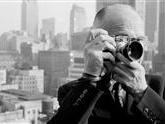
by T.V. Ramamurthy

IL Lib
|
article published in The Mountain Path, Jayanti Issue 2005, by T.V. Ramamurthy, a long time devotee of Sri Ramana. He is particularly interested in the lives of sages and saints and draws inspiration from them. |
The French photographer, Henri Cartier-Bresson died in early August 2004 at the age of 95. He was instrumental in influencing a generation of photographers on the way they viewd their subjects. In The Decisive Moment, a seminal essay written in 1952 for a book of photographs he released, he wrote about capturing the 'decisive moment': "Your eye must see a composition or an expression that life itself offers you." This term 'the decisive moment' has become synonymous with him. (The English title of Images a la Sauvett is literally, "Images on the Run")
With his relatively unsophisticated 35 mm Leica camera, he created a new direction in his medium. Like Hemingway in English literature or Picasso in painting, he reduced the subject to the barest fundamentals of geometry and revealed the essence of the moment. His work was about plain composition, immaculate clarity, stillness in movement and pure emotion - the decisive moment. Many of his images have a timeless quality because they are so 'true'. Though they do reveal sensations to the eye, the intent is not to excite but calmly reveal the composition's underlying harmony.
An amateur photographer clutters a scene with objects, in the belief that the more there is, the more is being said. In the end the viewer sees only irregularity and confusion. With Cartier-Bresson the meaning and value of the image is not in conveying information but the creation of stillness in the spectator where he can gaze and gaze free of preconceptions. We see with his eyes. His genius lay in his extraordinary ability to freeze-frame the 'decisive-moment' and bring to our attention the depth in a seemingly ordinary moment. As meditators, we can learn much from his restrained attitude. The detachment he brought to the framed subject exposed a depth of understanding that made the scene fascinating even with repeated viewing. That is why many of his images have become icons of the twentieth century.
He had a gift that was a mixture of intuition, patience, discipline, and it seems, sheer chance. This extraordinary ability to catch the moment was repeated so many times that one could not say it was accidental. It was a distinctive capability in tune with his nimble temperament.
It is no wonder other photographers were incredulous at Cartier-Bresson's consistent luck, as well as his skill which Cartier-Bresson described as 'the simultaneous recognition in a fraction of a second of the significance of an event, as well as the precise organization of forms that give that event its proper expression." This is the content plus geometry mentioned earlier.
One of his most famous pictures is the silhouette of a man frozen in mid-leap against the background of a Parisian railroad station. It has become emblematic of a style that reminds us that in photography the creative act must be performed immediately or lost forever. He stressed the importance of catching that vital moment, that fleeting instant separating good photography from cluttered images and chaotic composition and in doing so he revealed the sublime in the mundane. To live in the moment requires a mind that is focused in the moment with an intense and clear intent.
In his view, the photographer is not unlike an animal stalking its prey, waiting for that precise moment to 'seize the instant in its flight.'The metaphor of hunting naturally became a familiar one in writings about his photography. Cartier-Bresson himself used it often: "approach tenderly, gently on tiptoe - even if the subject is a still life". Or, "A Velvet hand, a hawk's eye - these we should all have." He also said, "I adore shooting photographs. It's like being a hunter. But some hunters are vegetarians - which is my relationship to photography." And later, explaining his dislike of the automatic camera, he would disparingly say, "It's like shooting partriges with a machine gun."
We do not know how he was able to create his images because the moment itself cannot be taught, as he told the aspiring young photographer Eve Arnold. He explained, "Learn your technique and then forget it, because if you are conscious about your technique all the time, you are doing it self-consciously." At another time, "You must know with intuition when to click the camera." More easily said than done.
His advice can be applied equally to our efforts at meditation and in particular, self-enquiry. At a certain point after mastering the basics of concentration we need to let go and trust that the present will unfold the truth in the mirror of our mind.
Cartier-Bresson had an extraordinary ability to be in the right place at the right time when some of the momentous moments in the twentieth century occured. For Indians and those who love India, Cartier-Bresson captured some unforgettable moments: Nehru standing on the railings at Birla House to officially announce the death of Mahatma Ghandi; and the ensuing funeral with lakhs of people perched even on precarious tree branches to gain a glimpse of the cortege and funeral pyre. The scene refrained as always from the easy melodrama by the rigorous form one expects from a French intellectual. A man of broad sympathies and a humane witness to suffering in the world, he did not fall into the trap of mushy sentimentality.
He was one of the last people to speak with mahatma Ghandi, some fifteen minutes before the death of the great man. they discussed a particular picture in a photographic book that Cartier-Bresson had shown him. Gandhi reportedly said, "I see death, death, death."
Other memorable images taken were the late patrician photos of Sri Aurobindo and of Swami Shivananda majestically captured sitting on a tiger skin by the Ganga, images indelibly impressed on the memories of their respective followers.
For Ramana devotees he is best known for the last three photos taken of Bhagavan on 4th April 1950. He was also at the ashram the night Bhagavan attained mahanirvana. In fact, he witnessed the glowing meteor that travelled north over Arunachala the moment Bhagavan left his body. Most people in the ashramm were so engrossed in the trauma of his death that they did not look up into the night sky. The photographer's words have been quoted in many books and articles about Bhagavan's last days.
Some of the photos he took on the subsequent day of devotees in grief during the ceremonies for Bhagavan's internment are among his most familiar images from his portofolio on India. In the haze of collective sorrow he recorded the intense emotions when a great soul departed from this physical realm, with a dispassionate eye sensitive to the individual's despair and disbelief. One does not feel he has intruded. Quite the reverse, he is absent from these pictures.
Many of us have a favourite photo and for me it is the famous one taken in Kashmir of four Muslim women clothed in burkas with their backs to the camera. As they look out over the valley, one woman raised her hands in supplication while the others mysteriously gaze out. What are they looking for? We shall never know and yet it doesn't matter. What does, is that Cartier Bresson has memorably caught a timeless moment. The photograph breathes an ageless air. The photo eloquently speaks for itself. It does not need words to explain it. It is self-sufficient.
It was while recuperating in Marseille in 1931 from a life-threatening attack of black-fever, that Cartier-Bresson acquired his first Leica. "I prowled the streets all day, feeling very strung-up and ready to pounce, determined to 'trap' life - to preserve life in the act of living,"he recalled. "Above all, I craved to seize the whole essence, in the confines of one single photograph, of some situation that was unrolling before my eyes."
We do remember his photos because they are so fresh and eloquent. He captured the fleeting moment and articulated it for us, as if we too, could live that instant with him.